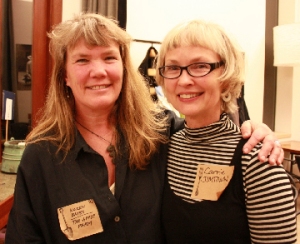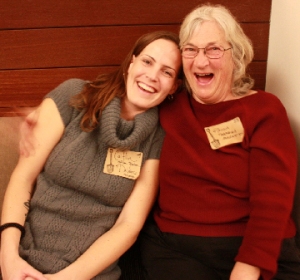(originally posted December 22, 2010)

For the second to last newsletter of the year, we thought it would be fun (and relatively easy) to take a quick look back at all the ‘dish of the weeks' we compiled and choose a winner. Fun yes. Easy? Not a chance. We were blown away with the sheer volume of mouthwatering images and fascinating cooking tidbits chef and I managed to compile in one short year. Choosing a dish each week is not based on science (discovering a new technique) or math (what sold the most), it's an ephemeral decision made a few days, sometimes a few hours, before compiling ingredients and shooting them. We did not set out to build what has turned out to be a fascinating food journal (a calendar? The start of a cookbook?). Only two things mattered: the joy of working together and the connection each dish had to a built-in reverence for great raw product, which always guides us.
What began as a bit of entertainment, a way to make the newsletter a more enticing read for you, turns out to be the best Christmas gift we could have given ourselves ~ a grace note to a year that, while it tested us in every way possible, ended up being more nourishing ~ in all senses of the word ~ than any that has preceded it.
Dish of the Week is very much a collaborative project ~ just as every dish we send out to the dining room must be. In this, Chef Ryan, Lukka, Geoff and I are supported by an insanely talented kitchen staff. A special call out to Tommy, who has brought so much to the table (literally and figuratively) this, his first year with us, and to Pancho, Danny and Drew, who always have our backs. A special note of thanks as well to my incredibly talented assistant, K2, who patiently works with me every step of the way to capture the essential spirit of each dish.
In the end, we could not come up with a single winner ~ so we give you our favorite meat, fish and vegetable entrées. While each in a special way contributed to the food narrative we try to tell here at Barndiva, a remarkable taste profile combined with the beauty of Ryan’s plating ultimately won our vote.
2nd Runner Up...
Compressed Watermelon Herb Salad This dish was the height of elegant simplicity, but only one of many that hummed with glorious local color, matched by a wonderful taste profile that brought the farm right into your mouth. We are blessed to have many produce partners, thanks in part to Fork & Shovel speed dating events we host here at the barn every year. Two of our favorite veg and fruit producers, Early Bird's Place and Mix, also contract plant for us, a business partnership more thoughtful restaurants are discovering. One of our most popular blogs this year was the one about Myrna and Earl Fincher (October 6th) whom you can buy from at the Healdsburg Farmers Market.
Herbs for these dishes, like most coming out of our kitchen, were grown right here in our raised beds behind the gallery, or at Barndiva Farm in Philo where we also get our dry farmed apples, pears, figs, and chestnuts.
1st Runner Up...
Fritschen Vineyard's Lamb's Liver & Onions 2010 marked the beginning of our collaboration with the Fritschen Family, whose vineyards boast the grapes that Thomas DeBiase, our sommelier, makes into fine wine here in Healdsburg. For three weeks in July we chronicled a nose to tail cooking project that utillized almost every part of a beautiful animal raised for us at the Fritschen Family Farm. Whenever we can, we will continue to work with local farmers to procure excellent animal proteins for Barndiva. We do this despite a lack of local humane slaughterhouses that make these purchases more expensive than it need be for both farmer and chef. In the coming year, look forward to more lamb from Fritschen and the wonderful Preston Family Farm, along with goats and rabbits from new farms. Every season we list on our menus at Barndiva the primary purveyors who inspired us to create that specific menu. Some can be found at your local Farmer's Market if you live in Sonoma, Marin, or Mendocino County.
AND now...the winner is...
Escabèche! Keeping the fish and shellfish selections interesting for our customers continues to be a challenge for us as we try to honor a commitment to primarily source from waters within 100 miles of the restaurant. Though we keep an open mind to ongoing science about the safety of farmed fish, we do not serve it in Barndiva for a variety of reasons (taste being only one). When I spoke at a Seafood Symposium at the U.C. Davis Bodega Bay Marine Aquarium a few years back, (a wonderful event, the brainchild of my good friend Randi Seidner produced by Slow Food Russian River,) I made the point that some responsibility must fall on the diner when it comes to helping restaurants source sustainable fish and shellfish. If you say you want local, do not turn your nose up at varieties you are not familiar with when a restaurant you trust serves it! Happily, there is such faith in anything Chef Fancher sends out of his kitchen that we are able to stretch with less familar local selections without fear it will hit our bottom line. The dish here, Escabèche, is a case in point. It sold out every time it appeared on the menu, often as a result of someone just seeing it come to an adjoining table or hearing our servers talk about it. Make no mistake: when a line caught wild salmon walks in the door in the arms of one of our fishmongers, we grab it. We love local halibut and sole. In the coming year we may cast our net as far as Oregon and Washington's coastal waters, but no fish served at Barndiva will have taken a plane ride to get to your plate, or ever been frozen.
The full collection of our Dish of the Weeks, are available in the Barndiva Journal Archives- or keep reading...














